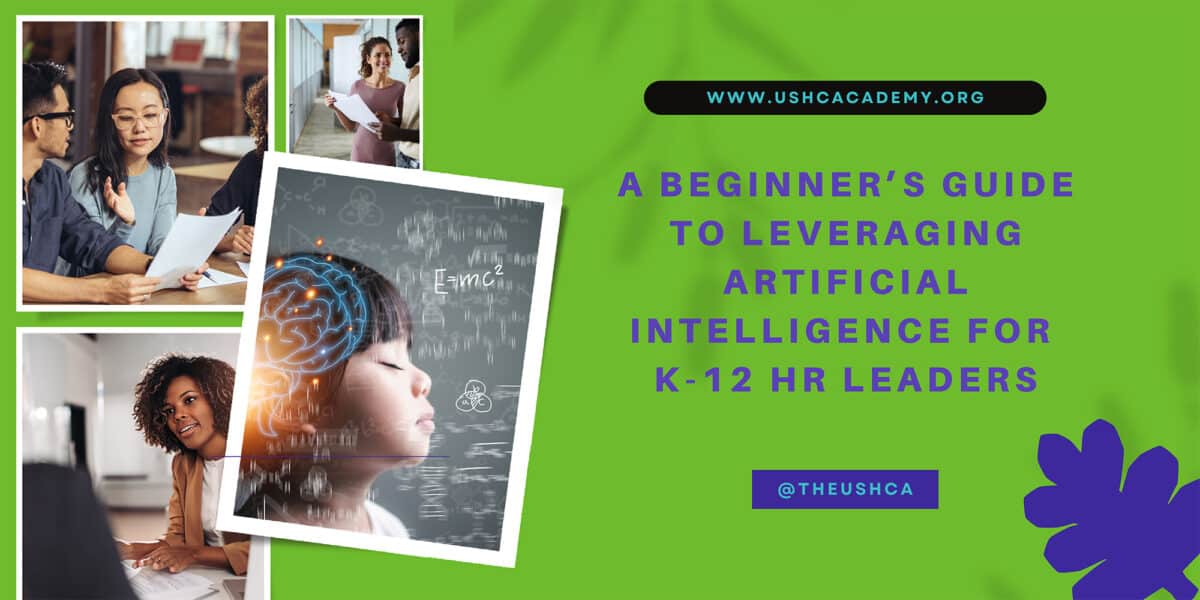
Written by: Danielle Pickens, Chief Program Officer, USHCA
Artificial intelligence (AI) is revolutionizing the way we work, and K-12 education is no exception. Even if your school system is not using AI yet, there are a multitude of ways AI can advance your individual talent work – by helping you generate new ideas, facilitating your continuous learning, and saving you time on routine tasks.
Ways You Can Use AI Today – Even if You’re not Tech-Savvy
Here are a few easy ways to experiment with AI, and specifically Large Language Models – like ChatGPT and Bard – if you’re a K12 HR/ Talent professional.
- Enhance Efficiency with FAQ Documentation
AI tools like ChatGPT and Bard can streamline your work by automatically generating responses to frequently asked questions. By training these models with clear instructions and examples, you can receive accurate and helpful answers, reducing the time spent on repetitive inquiries.
Example Prompt: Ask ChatGPT or Bard: “What are the key elements of an effective retention conversation for teachers?” Follow up with: “Can you provide me with a script for this conversation?” - Generate New Ideas and Strategies for Your Talent Challenges
Use AI to brainstorm creative solutions to common talent challenges. By providing specific prompts and instructions, you can generate diverse ideas, innovative strategies, and actionable insights to improve talent acquisition, retention, and development within your school system.
Example Prompt: Ask ChatGPT or Bard: “What ideas do you have for ensuring that not all novice teachers teach in the hardest to staff schools?” - Craft Recruitment and Retention Messages and Content
AI models can assist you in creating compelling recruitment and retention messages. By leveraging natural language generation, you can generate personalized content for job postings, newsletters, and internal communications, effectively conveying your school system’s values, benefits, and opportunities.
Example Prompt: Ask ChatGPT or Bard for a job description for a teacher in a high-needs school with the 3 must have skills. - Summarize New Research or Concepts
Stay up to date with the latest research and industry trends using AI models. When you come across lengthy reports or academic papers, these models can provide concise summaries, saving you time and ensuring you stay informed on relevant topics.
Example Prompt: Ask ChatGPT or Bard to explain the research behind why early hiring is important in school systems. - Translate Information into Other Languages
In diverse school systems, language barriers can pose challenges. AI models can aid in translating HR-related information into multiple languages. This enables effective communication with employees, parents, and stakeholders who may have limited English proficiency, fostering inclusivity and understanding.
Example Prompt: Ask ChatGPT or Bard to translate a recent document you created into another language. - Write Performance Reviews
AI language models can assist in drafting performance reviews. By providing specific instructions on the employee’s achievements, strengths, and areas for improvement, AI tools can generate well-structured and insightful reviews that can serve as a starting point for further customization and conversation. Be sure that your prompts do not share any personal identifiers to safeguard privacy.
Prompt: Ask ChatGPT or Bard to write a performance review for an individual on your team with 3 strengths and 2 areas for growth. Add in a few details/ specifics.
How to Get Started with AI
To maximize the potential of AI in your work:
- Start small and scale up gradually:
Begin with low-stakes experimentation, such as drafting an email, and gradually expand your usage as you become more comfortable with AI technology. - Provide clear and specific instructions:
For optimal results when using AI tools, be precise and detailed in your instructions. Don’t hesitate to revise your AI prompt until you obtain your desired content. - Be patient and persistent:
AI technology is continuously evolving and may not always provide the results you seek. Don’t be discouraged by initial challenges or limitations. Keep experimenting, learn from the experience, and adapt your approach until you find the optimal ways to utilize AI in your work. - Understand that AI still requires human judgment and review:
AI systems are not infallible and may occasionally make mistakes. Always review and verify the output of AI tools before taking action or making decisions based on AI’s recommendations. Check out this cautionary tale. Trust, but verify.
How HR Can Lead on AI
As your school system begins to more broadly adopt AI, HR can lead the way to ensure adherence to ethical and compliance guidelines – particularly as it comes to people processes.
- Keep data and employee privacy paramount
Safeguarding employee data and privacy should be a top priority. Implement robust data security measures, obtain informed consent, and adhere to relevant data protection regulations. Protecting sensitive information builds trust and maintains privacy rights.
- Review AI outputs for bias and mitigate impacts
Despite advancements, AI systems can inherit biases from the data they are trained on, leading to discriminatory outcomes. These biases can reinforce existing societal inequalities, perpetuate stereotypes, and result in unfair treatment. Addressing bias requires careful data collection, diverse representation, and rigorous evaluation of AI models. Ongoing efforts are essential to create more inclusive and equitable AI systems that prioritize fairness, transparency, and accountability. - Be transparent with employees about when and how AI is used in HR/Talent
Create clear policies and practices for when and how AI is used and openly communicate that to your employees. Address any concerns or questions they may have to foster trust and transparency. Maintain a record of how you use AI tools, including the decisions made based on their output. This documentation can serve as a reference point and help address any concerns or inquiries that may arise in the future.
If you’d like even more ideas on how to help your organization use AI responsibly, check out this recent article.
By following these tips, you can harness the power of AI to elevate your work as a K-12 HR leader, empowering you to work more efficiently and effectively.
P.S. Much of this blog was written with AI. Can you tell?

